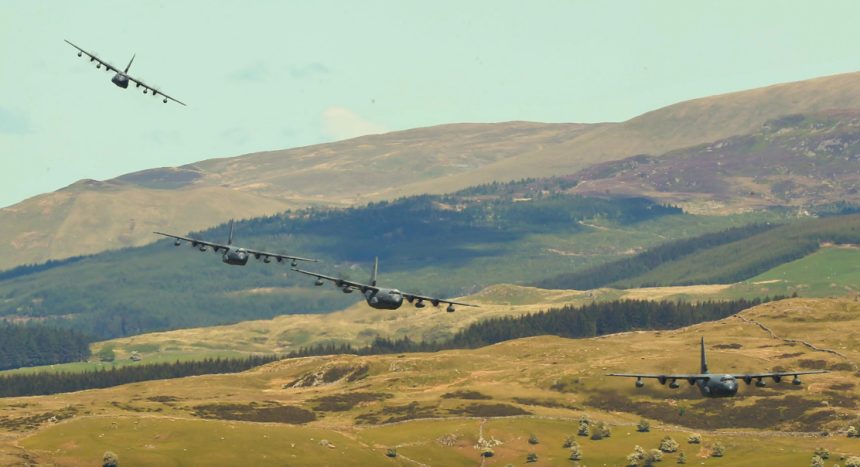Four Special Operations C-130s flying at low level: what an impressive sight!
In UK, training activities of combat aircraft at altitudes as low as 250 feet take place inside “Low Flying Areas” (LFAs). The mountains in these largely unpopulated areas scattered across the country, provide a challenging environment for pilots training in low level flying. Among the most used ones there are LFA-14 (Scotland), LFA-17 (Lake District) and LFA-7 (North West Wales). The latter has a system of valleys lined by steep sides with mountains either side rising to around 1,000 meters that allows the pilots to do training circuits at ultra-low level altitude: UK aviation enthusiasts have nicknamed it the “Mach Loop” after the small town at the circuits’ most southern point: Machynlleth.
Well before the Star Wars Canyon became the ultimate destination of aviation photographers pilgrimage, LFA-7 was popular among photographers from all around the world: stunning photos and videos have been taken of RAF, USAF, allied air arms as well as aerospace industries’ jets, turboprops, tilt-rotor aircraft and helicopters.
Here’s what I wrote about low level training, in a past feature about F-35 flying the the Sidewinder low level route in California:
[…] what makes the low level training so interesting, is the fact that aircraft flying the low level routes are involved in realistic combat training. Indeed, although many current and future scenarios involve stand-off weapons or drops from high altitudes, fighter pilots still practice on an almost daily basis to infiltrate heavily defended targets and to evade from areas protected by sophisticated air defense networks as those employed in Iran, Syria or North Korea. While electronic countermeasures help, the ability to get bombs on target and live to fight another day may also depend on the skills learnt at treetop altitude.
To be able to fly at less than 2,000 feet can be useful during stateside training too, when weather conditions are such to require a low level leg to keep visual contact with the ground and VMC (Visual Meteorological Conditions). Aircraft involved in special operations, reconnaissance, Search And Rescue, troops or humanitarian airdrops in trouble spots around the world may have to fly at low altitudes.
That’s why low level corridors like the Sidewinder and the LFA-7 aka “Mach Loop” in the UK are so frequently used to train fighter jet, airlifter and helicopter pilots.
And such training pays off when needed. As happened, in Libya, in 2011, when RAF C-130s were tasked to rescue oil workers that were trapped in the desert. The airlifter took off from Malta and flew over the Mediteranean, called Tripoli air traffic control, explained who they were and what they were up to, they got no reply from the controllers, therefore continued at low level once over the desert and in hostile airspace.
The most frequent visitors to the Mach Loop are the Bae Hawk T Mk1 or Mk2 flying from RAF Valley (only a few minutes flying time from the circuit), Eurofighter Typhoons as well as the F-15E Strike Eagles from RAF Lakenheath and U.S. AFSOC aircraft from RAF Mildenhall.
Based at RAF Mildenhall, the 67th Special Operations Squadron’s primary roles are HAAR (Helicopter Air-to-Air Refueling) of SOF helicopter/tilt rotor aircraft, infiltration, exfiltration and resupply of SOF by airdrop and land. The unit flies the MC-130J Commando II, mainly at low-altitude and at night, conducting clandestine missions with reduced probability of visual acquisition and intercept by airborne threats.
While single and multi-ship sorties are carried out quite often, a rarer sight is to see four MC-130Js peform a low-level tactical formation mission in the Mach Loop.
The video below was filmed at the end of May 2019. It shows, four MC-130Js doing not one but four circuits of the Mach Loop allowing Dafydd Phillips (make sure you subscribe to his Youtube channel here) to shoot the superb footage included in the clip.
Here’s another fantastic video showing the four MC-130J Commando II on the very same day. This one was filmed by our friend Peter Lewis (https://twitter.com/welshi233 and https://www.flickr.com/#/photos/55143939@N03/) and we published it on The Aviationist FB page.









